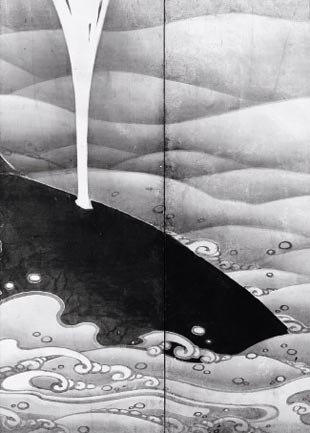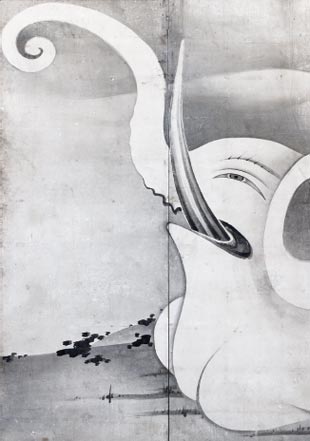

Japanese painting underwent an unprecedented blossoming during the mid-Edo period, in the eighteenth century. During the Kyōhō era (1716–1736), the lifting of the ban on Western books by the shogun Yoshimune, the importation of new Chinese Ming and Qing-dynasty painting styles, as well as the creative energy that the modern scholar Fujioka Sakutarō (1870–1910) described as a “reformation of old customs” led to a rise in new painting talent from among the burgeoning merchant class. In 1716, the artist Ogata Kōrin died in Kyoto. In the same year, Itō Jakuchū (d. 1800), who came to represent the new painter of the merchant class, was born. During this period, realistic sketches of nature under the guidance of intellectuals were popular–the painter Maruyama Ōkyo (1733–1795) being one of the most representative. Jakuchū also studied and fervently sketched flowers, birds, and animals from life. Although he painted his
flora and fauna with meticulous detail, he also created a fantastic wonderland that was separated from reality.

In contrast to his elaborate works, Jakuchū also produced ink paintings with quick, abbreviated brushstrokes. From his subjective view erupted a wild, uninhibited realm with the innocence of a child’s painting. This too is a product of Jakuchū’s imagination that resonates with our modern sensitivity and that has attracted much attention in recent years.

This exhibition presents the recently discovered pair of six-fold screens Whale and Elephant for the first time in public as well as other Jakuchū masterpieces from both domestic and international collections. Also featured will be contemporaneous Kyoto artists, such Ike no Taiga (1723–1776), Yosa Buson (1716–1783), Soga Shōhaku (1730–1781), and Nagasawa Rosetsu (1754–1799), who painted fantastical, large-scale works.
In contrast to his elaborate works, Jakuchū also produced ink paintings with quick, abbreviated brushstrokes. From his subjective view erupted a wild, uninhibited realm with the innocence of a child’s painting. This too is a product of Jakuchū’s imagination that resonates with our modern sensitivity and that has attracted much attention in recent years.
This exhibition presents the recently discovered pair of six-fold screens Whale and Elephant for the first time in public as well as other Jakuchū masterpieces from both domestic and international collections. Also featured will be contemporaneous Kyoto artists, such Ike no Taiga (1723–1776), Yosa Buson (1716–1783), Soga Shōhaku (1730–1781), and Nagasawa Rosetsu (1754–1799), who painted fantastical, large-scale works.
